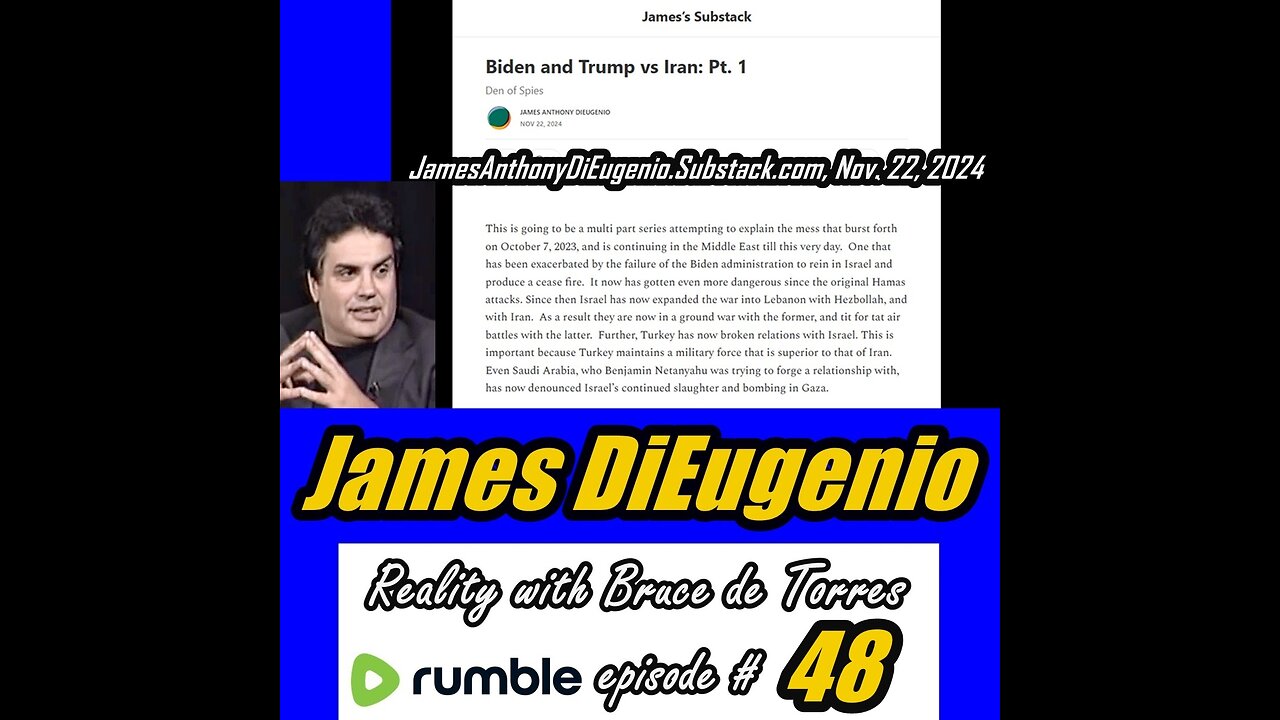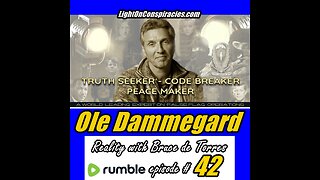Premium Only Content

RWB 48 James DiEugenio
Reality with Bruce de Torres 48 James DiEugenio
The October Surprise/Treason of Reagan’s 1980 Campaign
James DiEugenio is the editor and publisher of KennedysandKing.com, where you will incredible history about the assassinations of JFK, Malcom X, Martin Luther King and Robert F. Kennedy, and much that has happened since, up to and including what’s happening today.
Jim has written or co-edited many books on those assassinations, including JFK REVISITED, the companion piece to Oliver Stone’s two recent documentaries, for which Jim wrote the screenplays, JFK REVISITED: Through the Looking Glass and JFK: Destiny Betrayed.
His latest book, with four co-authors, is THE JFK ASSASSINATION CHOKEHOLDS That Inescapably Prove There was a Conspiracy.
His article series, Biden and Trump vs Iran: Den of Spies, which can be found at jamesanthonydieugenio.substack.com, was inspired by the book, DEN OF SPIES: Reagan, Carter, and the Secret History of the Treason That Stole the White House by Craig Unger, and by the dangerous tit-for-tat air battle between Iran and Israel, which has also included Hezbollah and now has culminated with the overthrow of Assad in Syria. The past events of which Jim writes have a strong influence on what’s happening in the region today, Jim believes.
For instance, one reason Iran has a formidable military force is because the Shah of Iran, at the pinnacle of the 1960s and ‘70s, was buying over $9 billion dollars a year of American arms. All those presidents, except Kennedy, had no problem selling them to him. Nixon. Ford. Carter. Those weapons had to be re-stocked. That was the reason for the October Surprise, where Reagan’s campaign team in 1980 made a deal with Iran to delay the release of the American hostages until after the November election, so their release would not help President Carter in the election.
Iran was buying all kinds of jet fighters. Fighter bombers. Missiles. Tanks. William Casey, Reagan’s campaign manager, made a deal with the Iranians in Madrid and Paris to sell them the spare parts that they needed for this weaponry. To understand this and how Iranian-American relations have gotten so bad, you have to go back to Mohammad Mosaddegh, the popular prime minister that the CIA ousted in a coup in 1953.
Jim recounts how Mosaddegh worked for Iran’s interests, and how America overthrew him to join England in controlling and profiting from the sale of Iran’s oil. (The English fleet patrolled the seas and protected the British Empire, which at one time ruled 25% of the globe.)
The CIA paid Iranian students and clerics to protest Mosaddegh in manufactured demonstrations and bribed or killed generals to get the military to go along with regime change. CIA director Allen Dulles told everyone in Washington that Mosaddegh was in league with the communists and was going to side with the Soviet Union in the Cold War.
Jim believes that the overthrow of Mosaddegh and the return of the Shah was a mistake by the British, the U.S., the CIA, Allen Dulles, and Richard Nixon (vice president at the time) that cannot be overestimated. Dulles knew that the only way the Shah could stay in power was through an incredible amount of terror and suppression.
The CIA deployed a tremendous bribery budget and supervised the police force. They supervised the military. They created and supervised a secret organization called SAVAK, an intelligence agency like the CIA. The mullah class in Iran was also bribed, because the CIA knew that the clerics did not want the Shah.
All dissident press, all dissident speakers, were tracked down by SAVAK, not just in Iran but also abroad. They detained and imprisoned everybody opposed to the Shah being returned to Iran. A lot of them were tortured. Some of them were killed.
This created the resentment of a martyr class, and an underground resistance began to organize against the Shah, made of two segments of society: the dissident clerics and the former followers of Mosaddegh. The cleric protesters were led by Ayatollah Khomeini, who had been on the CIA payroll, protesting Mosaddegh. The former followers of Mosaddegh were led by Bani Sadr. The Shah a brutal reign of terror more or less in the pocket of the United States.
The Shah allowed military bases and surveillance, valuable because of Iran’s proximity to the Soviet Union. He also granted the Americans many kinds of privileges inside his country, which of course was very unpopular with Khomeini and Bani Sadr, because Mosaddegh would never have done anything like that. But the Shah understood that he owed his throne to the United States and the CIA.
The only president who had any problem with this was Kennedy. He and his brother Robert, the new attorney general, decided that something had to be done about the Shah. They knew that they could not be in bed with a brutal, bloody dictator and talk about spreading democracy to the rest of the world.
Kennedy liked Nasser in Egypt, a populist who wore a suit instead of religious garb. So, Kennedy required the Shah to make reforms, which he agreed to do. It was called the White Revolution. Land reforms. Giving women more rights. Improving literacy. Building more schools.
But after Kennedy was assassinated in 1963, Nelson Rockefeller got his friend, new president Lyndon B. Johnson, to relax the pressure, because the Rockefellers had a share of the Iranian oil business as a payment from the Shah for the CIA’s overthrow of Mosaddegh in 1953. So, the White Revolution was relaxed and the Shah reverted to what he was before.
In 1964, the Shah did something very weird. As a payback to Johnson, the Shah allowed immunity to Americans in Iran for any crimes they may have committed. When this announcement was made, the Ayatollah Khomeini really went off the edge and started making really powerful speeches, saying that this is another example of America controlling Iran, asking, “Do you really think that the Americans are going to come in and put someone on trial in New York City for a crime committed in Iran? What makes them better than Iranians?” He hammered this issue day after day after day.
This caused the Shah to exile the Ayatollah out of Iran. The Shah also gave his support to the Johnson administration’s escalation of the war in Vietnam and its invasion of the Dominican Republic.
Jim describes the “bromance” that followed between President Nixon and Henry Kissinger and the brutal, bloody dictator, the Shah of Iran, calling it the greatest example of the difference between John F. Kennedy and Richard Nixon. “Nixon actually held up the Shah as a model of stability and culture in the Middle East.”
Nixon grew up politically by the side of John Foster Dulles, Eisenhower’s secretary of state, for whom there was no such thing as neutrality in the Third World. You were either for the United States or you were against the United States. There was no middle path. That was Nixon’s attitude. As long as you were in bed with the United States, it didn’t matter what you were doing at home.
And Kissinger felt the same way. Kissinger worked for Nixon and then for Ford. So, for about a decade, the Shah was going on a giant shopping spree buying our weapons. And Nixon and Kissinger cancelled the annual review of Iran’s behavior normally required by purchasers of our weapons, freeing the Shah from any requirement to advance civil or economic rights or improve the quality of life in his country.
The Shah feared that Jimmy Carter would be another Kennedy and force him to make reforms. But that didn’t happen. But because Carter talked about human rights in public, students in Iran and Iranian students in America took him seriously and began to protest the Shah and his oppressions.
Carter national security advisor, Zbigniew Brzezinski, convinced Carter to visit the Shah in Iran when the riots were beginning. And the Shah did something very stupid. He unleashed SAVAK at the start of these riots. This created a chain reaction. The Shah didn’t realize how much he was hated by these young students who were reading about their overthrown prime minister, Mohammad Mosaddegh. Town after town and city after city began to erupt. This went on for about months. The SAVAK was going wild. Breaking into homes. Throwing people into jail. Firing bullets into demonstrations. An estimated 12 to 15 thousand people were killed.
The Shah saw that nothing was going to stop the bloodbath. He decided to abdicate and left Iran. A few days later both Bani Sadr and Ayatollah Khomeini flew into Teheran. Enormous crowds welcomed them and shouted, “Death to the Shah! Death to the United States!” And the Ayatollah decided not to honor his deal with Sadr (to share power? To create a moderate government?) because he saw that he could create a theocratic state.
Mid-interview Jim reviews the deal to hold the hostages until after the election. The secret meetings that arranged it. The weapons that shipped while Carter was still president. The four hours that the hostages sat on planes at the airport in Iran, waiting for Reagan to be sworn in on January 20, 1981. And the fact that they took off only after Reagan had taken the oath in Washington. “This huge scandal, which should have put a lot of people in jail, went unobserved [by the mainstream media].”
Trump and Biden did not lure Iran toward peace with diplomacy. And now Israel’s tit-for-tat air battle with Iran endangers the world with the chance of escalations that could lead to a nuclear war between Russia and the United States.
Also discussed is how JFK Jr. was a good pilot, that an explosion took down his plane in 1999, and that JFK Jr. was going to make public evidence implicating George H. W. Bush in his father’s assassination.
REALITY WITH BRUCE DE TORRES
Videos at rumble.com/c/c-5939994
See more at brucedetorres.com
-
 1:17:14
1:17:14
Reality with Bruce de Torres
3 months agoReality with Bruce de Torres 42 Ole Dammegard
230 -
 1:14:05
1:14:05
Tucker Carlson
21 hours ago“I’ll Win With or Without You,” Teamsters Union President Reveals Kamala Harris’s Famous Last Words
253K394 -
 1:58:31
1:58:31
The Dilley Show
21 hours ago $38.23 earnedTrump Conquering Western Hemisphere? w/Author Brenden Dilley 12/23/2024
184K50 -
 1:09:59
1:09:59
Geeks + Gamers
22 hours agoSonic 3 DESTROYS Mufasa And Disney, Naughty Dog Actress SLAMS Gamers Over Intergalactic
125K21 -
 51:59
51:59
The Dan Bongino Show
23 hours agoDemocrat Donor Admits The Scary Truth (Ep. 2393) - 12/23/2024
973K3.28K -
 2:32:15
2:32:15
Matt Kohrs
1 day agoRumble CEO Chris Pavlovski Talks $775M Tether Partnership || The MK Show
151K36 -
 28:23
28:23
Dave Portnoy
1 day agoDavey Day Trader Presented by Kraken - December 23, 2024
181K47 -
 59:29
59:29
BonginoReport
1 day agoTrump, Murder Plots, and the Christmas Miracle: Evita + Jack Posobiec (Ep.110) - 12/23/2024
181K177 -
 2:59:14
2:59:14
Wendy Bell Radio
1 day agoNothing To See Here
141K81 -
 2:12:18
2:12:18
TheDozenPodcast
1 day agoIslam vs Christianity: Bob of Speakers' Corner
121K37